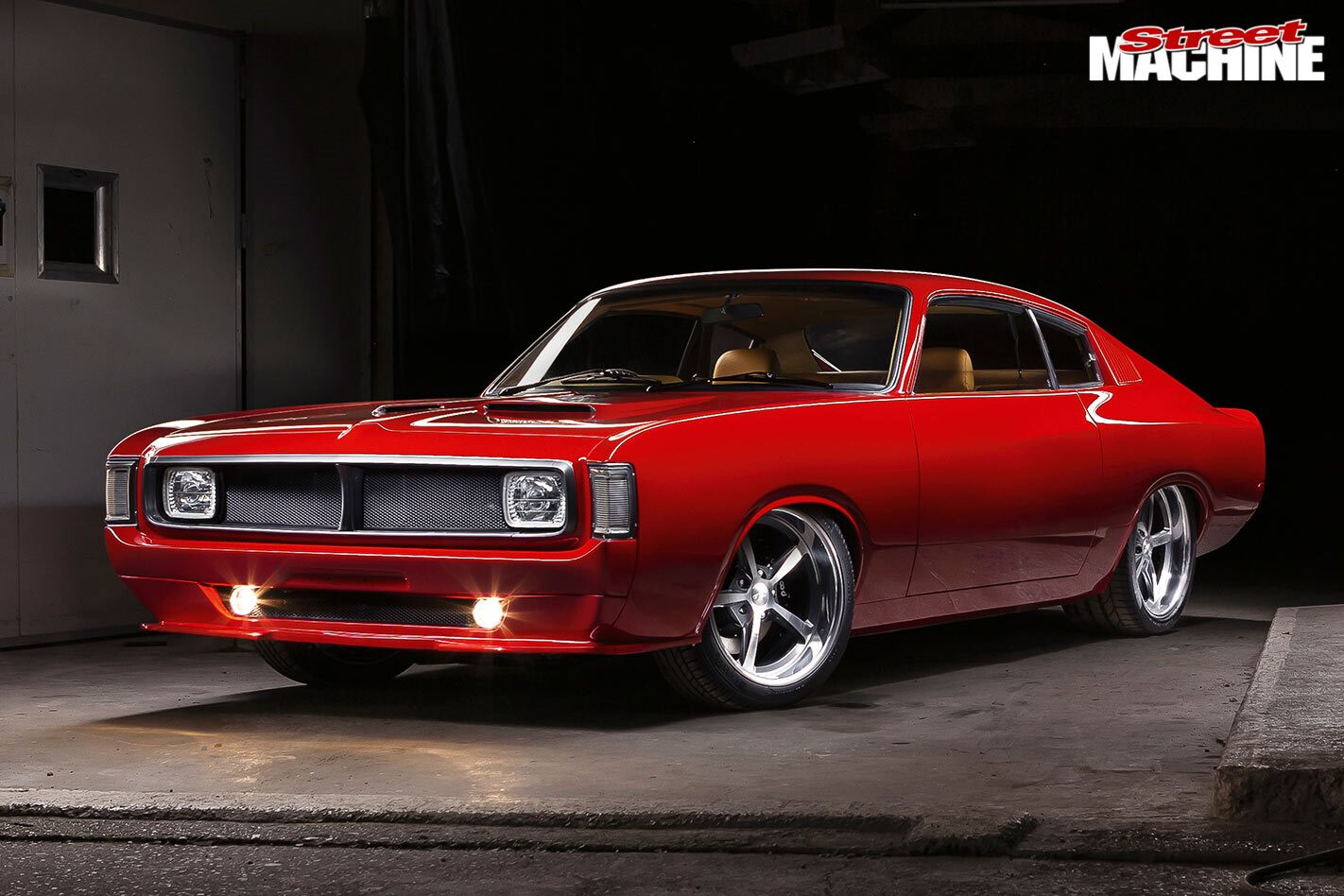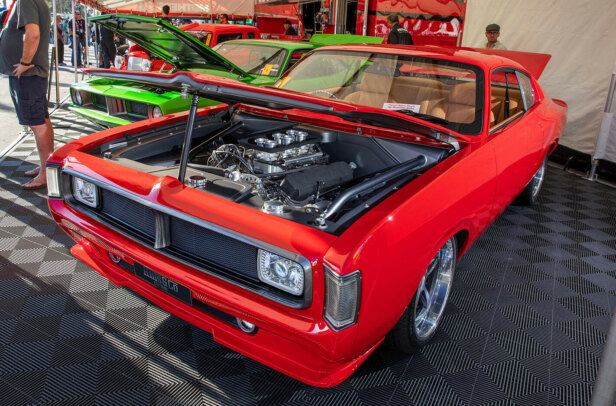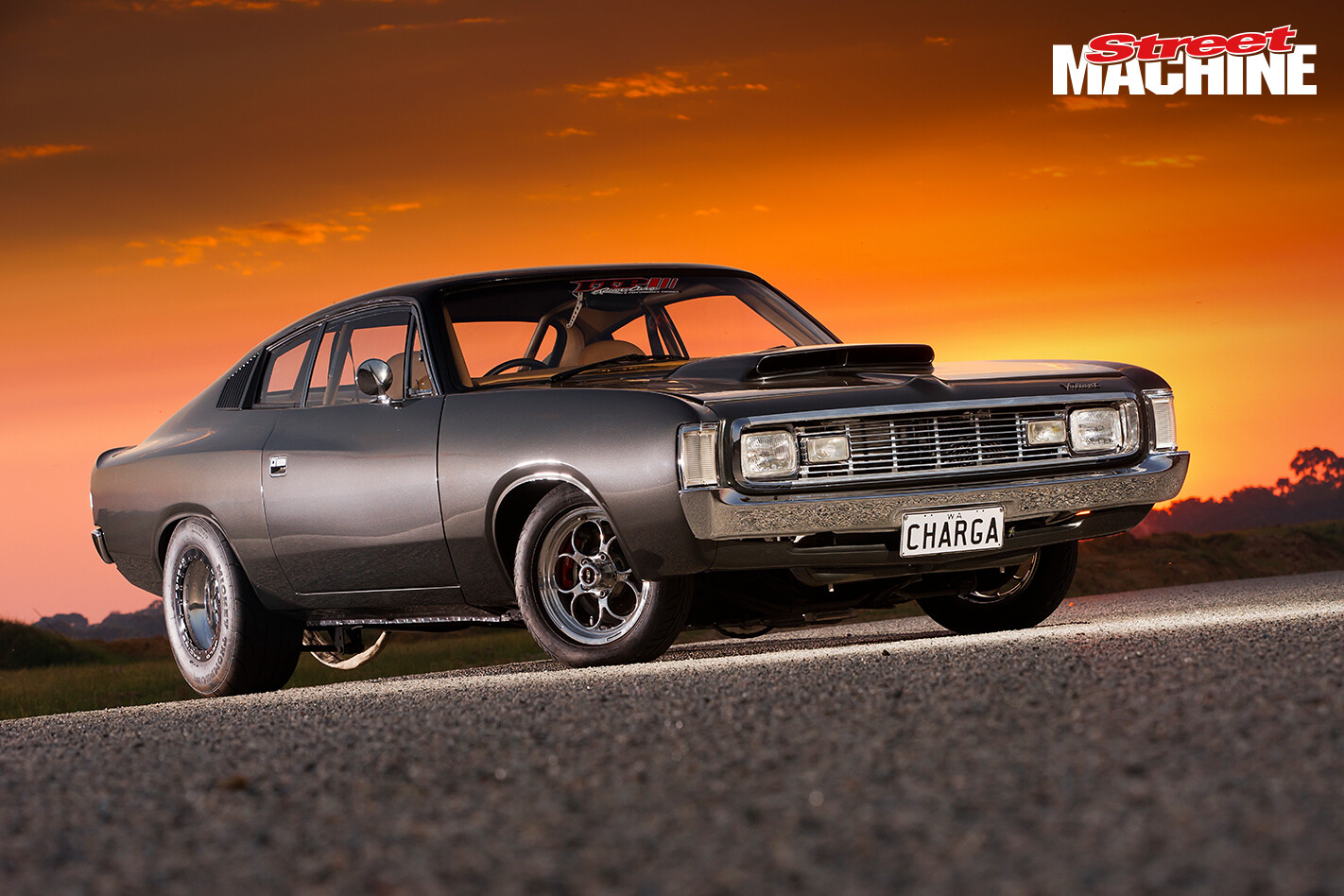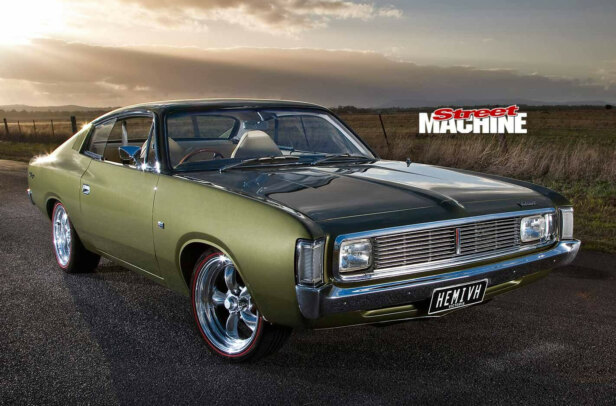THIS modern, European-influenced vision of a VH Valiant Charger may well be one of the most well-thought-out street machines ever built in this country. It might not be the most visually modified or have Ridler Award-winning detail, but in terms of being built with a very clear set of design objectives – and meeting them – few cars come close. A major factor in that achievement is how long Mario Ciarrocchi has had to formulate the ideas in his head – after all, he’s owned the car since 1986.
This article was first published in the September 2019 issue of Street Machine
The rear end is a masterful blend of old and new that is directly inspired by the Ferrari 599. The fuel cap is also a modern version of the original that’s been recessed for a cleaner look
“My father and I bought the car when I was 17 years of age,” Mario explains. “Thirty years later, he mentioned that he knew that I had an interest in cars and that he’d bought the car to keep me occupied and out of trouble.”
With the help of a good mate, after about two-and-a-half years Mario got the car back on the street with fresh paint, a 265 filled with forged Chevy pistons and triple Dellorto carbs. For the next 10 years or so Mario drove it regularly; then, as his career developed and he started getting company cars, the Charger got tucked away in the garage and sat there for the next 15 years.
There were no major changes to the original design, but everything has been tightened up for a much more modern look. Ben Hermance designed the front spoiler, which was then expertly recreated in steel by Hills & Co Customs
Building a family and a successful business took priority, but the Charger was never far from Mario’s mind, and as his business grew, so did his ideas for what the Charger could become.
Being a successful business owner brought more benefits than just being in a stable financial situation, too: “You have to be pretty organised, so I used those skills to build the car,” Mario says. “I don’t mean I physically built the car – I don’t have the time and I don’t have the skill set – but I planned everything and did a lot of research, which took me about two years.”
Mario had three design objectives: Stay true to the original design, modernise the car throughout, and use European design cues, specifically from Ferrari. As you can see, all three of those objectives were well and truly met
All that time doing research led him to a couple of key people who were instrumental in creating the car. The first was Ben Hermance of Hermance Design in the US. “I liked what Ben did because he would get an old car and tweak it and tuck it, but the original design of the car would still be there,” Mario says. “I really liked it, so I just rang him and asked if he would be interested.”
With the designer locked in, the next piece of the puzzle was to find who could carry out the work and make Mario’s vision come to life. It wasn’t long before Mario homed in on Justin Hills from Hills & Co Customs. “A friend of mine had a Mustang built by Justin and he introduced us at MotorEx 2013,” Mario explains. “Because he does high-end restorations on a lot of European stuff, I thought this guy would understand exactly where I was coming from. I explained to Justin what my ideas were for the build and in October of 2013 the car was transported to Taree.”
Before the Val was loaded up, there was one last thing Mario wanted to do on the car himself: “I said to Justin: ‘Let me take the engine and gearbox out; I just want to do it one more time, just for the hell of it.’” From that point on, the car was built entirely at Hills & Co Customs, with external help brought in when needed. For six years they worked away on the car without sharing a single thing on social media. That’s a rare thing these days, but it made the Charger’s impact all the more astounding when it was unveiled at the 2019 Sydney Hot Rod & Custom Auto Expo, catching everyone by surprise and winning Top Coupe and the Austin Arrowsmith Elegance award.
When Mario was unable to find a wheel design he liked, Ben Hermance offered to create a new one for his Grip Equipped line. The design is a modern version of the Magnum 500 wheels found in the early-70s Chargers. Manufactured by EVOD Industries, the rims measure up at 18×7 and 19×11 and wear 205/45 and 305/30 Pirelli P Zero rubber respectively
With a build like this, you can run the risk of the car looking dated before it even gets finished, but that’s not the case with this Charger. The modern elements have been seamlessly intertwined while keeping enough of the car’s original design to create a timeless look. Let’s face it, Ferrari Red paint and a fawn interior isn’t exactly groundbreaking stuff, but it will never go out of fashion either – and more importantly, it ties in perfectly with the overall build theme of Euro style meeting Aussie muscle.
Mario’s Italian heritage was a big factor in the numerous Ferrari influences in his Charger, but there was already a strong connection between Italy and Chargers from back in the 70s, when Chrysler sent a car back to the Weber factory to fine-tune the Six-Pack carby set-up. With Chrysler and Weber both now owned by Fiat, I guess you could say that connection is even stronger.
The modern style with a Euro twist was also carried through to the Charger’s interior. “What I wanted to do with the interior was give it a Ferrari/Dodge Viper feel in there,” Mario says. “I said to Ben when he drew it up: ‘It has to have a dash like the R/Ts with the six gauges in line, and the other thing I really want is the Daytona stitching like you find in the early-70s Ferraris.’”
Once Mario was happy with the design, the trim job was handed over to Scott Briggs from Trik Trim to work his magic. It was a pretty major undertaking, with handcrafted door trims, one-piece moulded headliner and a full-length console being fashioned. The front seats are out of a Hyundai Tiburon, and two bucket seats were fabricated for the rear. Blending a modern interior with a classic Aussie muscle car is one of the toughest jobs to get right, but they absolutely nailed it with this one.
It’s the same with the exterior; thanks to a well-thought-out and thorough design process, all of the exterior changes complement the original styling. While the amount of work done to the car is pretty radical, the end result is far from it, with the original VH Charger styling shining through. Some of the changes are pretty obvious; the front spoiler and rear diffuser are probably the most easily picked, as is the removal of the door handles. But how about the drip rails? A lot of people would have simply shaved them off, but Hills & Co masterfully reworked them so that they sit a lot tighter to the body, and the parting line between the rocker panel and front guard now extends through to the wheel opening. The sill panels have also been extended and lowered. As Justin Hills puts it: “With the body, although it looks simple and uncluttered, every panel has been worked and modified.”
If you didn’t know you were looking at photos of a ’72 Charger, you could quite easily think this was a modern sports car interior. More Ferrari inspiration comes from the Daytona stitching design in the seats
One of my favourite parts of the car is the bonnet. Reshaped in steel with custom-made scoops, it was then used as a mould and recreated in carbonfibre for rigidity and weight saving – another area that Mario focussed on with the build. “One of the main things I wanted to do was reduce the weight of the car, so instead of doing a 1000hp engine, I’ll go the other way and do a 600-650hp engine and lower the weight, especially at the front,” he says. “The carbonfire bonnet and all-aluminium engine and the Magnum Force front end takes about 150kg out. We haven’t weighed it yet, but I reckon it weighs about the same as when it had the six-cylinder in it – but it’s got double the horsepower.”
By now you’ve probably figured out that the 265 and triple carbs are gone and seen the stonking big-block tucked neatly into the engine bay. Built by Tony Khattar from All Cylinder Head Services, the 540-cuber is based on an Indy block and heads from 440 Source. There’s still a Six-Pack, but this time they’re F&B Performance throttlebodies controlled by a FAST XFI 2.0 ECU. Even the engine bay copped some Ferrari styling, with wrinkle finish on the rocker covers and custom-made intake bellmouths. “I didn’t want any bling – it’s an engine bay for crying out loud; it’s going to get dirty,” Mario says. “If you look at a Ferrari or a Lambo, you don’t see a lot of bling. You see a lot of dark stuff, you see all the mechanicals, the engineering that’s there. That’s where your eyes go.”
The R/T-inspired dash features custom-made gauges from Classic Instruments housed in bezels machined by Greening Auto Company. Warning lights are from New Vintage USA
Proof of how sympathetic the build was to the original design can be found in the comments from Bob Hubbach, the Charger’s original designer, after Mario sent him some photos: “Your car looks sensational in the photos you sent. Did you perchance send these photos to the authors of the Hey Charger book – Gavin Farmer and Gary Bridger? I’m sure they would like to see them and that they would be as impressed as I am.”
The TCI six-speed auto can be controlled by the shifter, or at the press of a button it can be switched over to paddle shift
“My idea for the car was to keep all the beautiful things about the Charger and just clean it up a bit and make it look more modern,” says Mario. The end result? A classic Aussie muscle car with European styling and Yankee big-block power; a real triple threat – or should that be triple treat?
HILLS’ HOIST
BUILDER Justin Hills has plenty to say about the extent of the work he and his team performed on Mario’s Charger.
“Under the car is a work of art, with a custom gearbox tunnel and full fabricated crossmember that bolts in and has cut-outs to accommodate the 3in exhaust,” Justin says. “Chassis plates were fabricated to connect the front and rear subframes together. This was quite a task, as the Charger has a very undulating undercarriage.
“The rear end was also quite a bit more work than the manufacturer would have us believe,” he continues. “We fabricated huge wheel tubs to house the 305/30/19 rear tyres. We also made extra bracing in the rear chassis inside the car for extra strength around the rear-end mount points.
“The underside of the car is painted in the same satin grey finish as the engine bay, with gloss black components and polished Jet-Hot exhaust coating. It continues the same smooth, simple style from the engine bay throughout the whole undercarriage. To finish off underneath, the custom-made fuel tank blends from the rear suspension right back to melt into the rear diffuser.
“The reaction we got at the Hot Rod & Custom Auto Expo was that every time you look at it you notice something else that had been done. I feel the best custom cars are the ones that people can’t see what has been done, but they know it is different and can’t work out why.”
ENGINE BAY:
- The induction system is a tribute to the classic Mopar Six-Pack but done with a modern twist using F&B Performance EFI throttlebodies. Inspiration also comes from Ferrari, with the wrinkle finish on the rocker covers and bellmouths inspired by the 250GT.
- The bar gives support to the Magnum Force front suspension and provides a mounting point for the engine plate.
- The EFI utilises a FAST XFI 2.0 ECU to control the fuel delivery. The staggered bellmouths were custom-fabricated by Hills & Co Customs.
- While there is plenty of custom work, the car still retains a lot of the factory sheet metal, including the inner guard structure and firewall seam
MARIO CIARROCCHI
VH VALIANT CHARGER
Paint: Glasurit Ferrari Rosso Corsa
ENGINE
Type: 540ci big-block Chrysler
Inlet: Edelbrock
Injection: F&B Performance
ECU: FAST XFI 2.0
Heads: 440 Source Stealth
Valves: 2.14in (in), 1.81in (ex)
Cam: 254/[email protected]
Pistons: Diamond flat-top
Crank: 440 Source
Conrods: Scat
SHIFT
Gearbox: TCI six-speed auto
Converter: 2500rpm stall
Diff: Heidts 9in IRS, 3.7:1 gears
BENEATH
Front end: Magnum Force
Rear end: Heidts IRS
Shocks: Coil-overs (f & r)
Steering: Rack-and-pinion
Brakes: Wilwood 13in discs and six-piston calipers (f), Wilwood 12in discs and four-piston calipers (r)
ROLLING STOCK
Rims: Grip Equipped by EVOD; 18×7 (f), 19×11 (r)
Rubber: Pirelli P Zero; 205/45/18 (f), 305/30/19 (r)
THANKS
The following suppliers: Indy, 440 Source, F&B Performance, FAST, Holley, Edelbrock, Scat, Diamond Pistons, Crane Cams, Lokar, Milodon, Magnum Force, Heidts, TCI, Wilwood, Infinitybox, Classic Instruments, Fesler, New Vintage USA, Grip Equipped, EVOD industries, Bliss Custom Machining, Pirelli, Drake Automotive, Clayton Machine Works and Greening Auto Company; the following builders and designers: Justin Hill at Hills & Co Customs, Ben Hermance at Hermance Design, Tony Khattar at All Cylinder Head Services and Scott Briggs at Trik Trim; my wife for the support throughout the six-year build




Comments